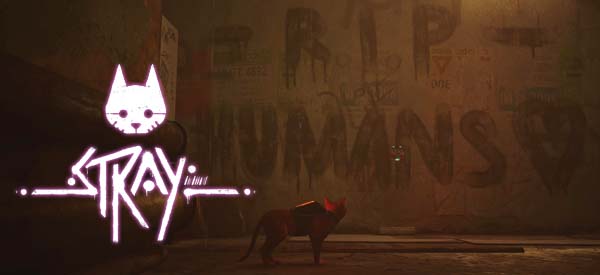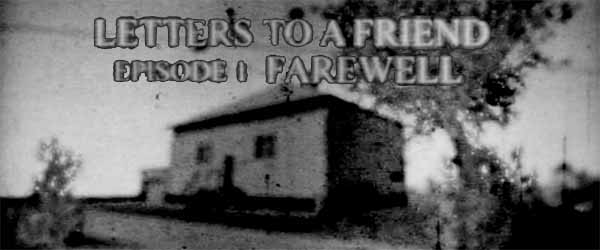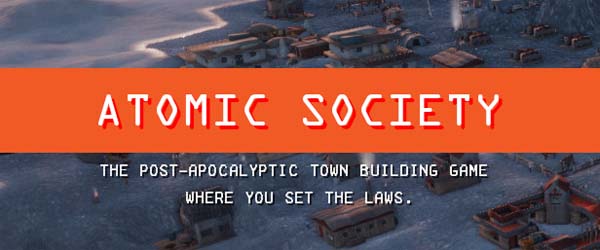When I booted up my PS5 for the first time and signed into the PSN, I immediately downloaded a few of the must-have games. You know, the Demon's Souls remake, Miles Morales, and Returnal. I also downloaded some other ... shall we say "less high profile" games that piqued my interest, including the [ultimately very impressive] World War II shooter Hell Let Loose and a little indie game that claimed to be a sequel to H.G. Wells' classic sci-fi novel The War of the World, called Darker Skies.
Darker Skies takes place during the aftermath of H.G. Wells' classic novel The War of the Worlds,
but the visual and sound design is clearly pulled from the 2004 Steven Spielberg movie starring Tom Cruise.
Budget "Last of Us"
I didn't have high hopes for this budget indie title, but I was curious what a game developer would even do with a property like War of the Worlds. As soon as I saw the first enemy, a zombie shambling around just like a Clicker from The Last of Us, my heart sank. With all the potential of the source material, Steel Arts had to go with a zombie game?! The War of the Worlds is a classic sci-fi novel about a Martian invasion of Earth. My expectation for a video game adaptation of The War of the Worlds would either be some kind of survival horror game about surviving against Martians who survived exposure to Earth's microbes, or an action shooter about humans counter-attacking the Martians on Mars, or something akin to XCOM. It absolutely would not be a total knock off of The Last of Us, right down to having infected zombie humans.
And when I say this is a knock off of The Last of Us, I'm not just talking about the presence of Clicker-like zombies. The protagonist has an X-Ray "focus" vision, he scavenges random supplies in order to craft consumables supplies, and most encounters with enemies are intended to be dealt with by various throwable tools. There's even areas of the map that are overgrown with red Martian tendrils, similar to the spore-infested areas of The Last of Us, except this time around, the character doesn't need a gas mask to get through.
The character can use X-ray vision to detect enemies through walls, but only if they are moving.
The only thing missing is the tag-along NPC child character -- which is a big problem because the interactions between the two characters is a huge part of what makes The Last of Us a great game. That's where the heart and soul of that game was. If you played The Last of Us, and you thought the best thing to emulate is the crafting system, then I feel like maybe you missed the point...
[More]
72490b38-a75a-4bb0-8c2c-627a390787ae|1|2.0
Tags:Darker Skies, Steel Arts Software, indie gaming, PS5, H.G. Wells, The War of the Worlds, science fiction, horror, survival, crafting, zombies, The Last of Us

When some of the trailers for Stray started releasing on the internet a couple months ago, a couple of my co-workers were really enthusiastic about it. I took one look at the trailer, and pretty much had the entire game figured out. But the idea of playing as a literal cat (as opposed to an anthropomorphized cartoon mascot cat) seemed novel enough for me to toss the game on my Steam wishlist. I ended up buying it on PS5 though, since the price was the same and my aging PCs might not be able to render all the pretty, ray-traced neon lights of the game's cyberpunk dystopia setting.
Right off the bat, I was surprised that Stray does not feature any kind of customization for the cat. I had a bit of a Mandela effect going on in which I could have sworn that the trailers I watched earlier in the year showed customization. But no, we're all stuck with the same orange tabby cat. At the very least, I feel like the developers could have given the player the option to play as one of several pre-fab cat models. The game begins with 4 cats in a little colony, and it seems like the developers could easily have given players the option of which of the 4 cats we want to play with. Ah well. Not a big deal.
I wish there were options to customize the cat or play as different pre-made cat skins.
After being separated from the other 3 cat buddies, the one playable cat must navigate a walled-in dystopian cyberpunk city to find its way back out to its colony. This is done by progressing through a linear route through the environments and completing collections of 3 various types of activities:
- Run away from hostile critters,
- Explore small sections of the city populated with humanoid robots for keys, collectibles, and lore,
- Do some light stealth.
Cyberpunk cat tower
The best parts of the game are easily the exploratory sections, as they are the most free-form and best utilize the novelty of the feline protagonist. The levels all have a significant vertical element to them, and the low-angle camera gives an impressive sense of scale. All the spaces are very small horizontally, never representing more than a single city block, but they are easily doubled or tripled in terms of traversable size when the vertical spaces are factored in. A simple, 3-story tenement building might as well be the Empire State Building from the perspective of your foot-tall feline avatar.
If the player isn't routinely looking up, climbing where you can, and squeezing into tight spaces, you'll likely miss a lot of the game's secrets and collectibles. Though if you are testing the verticality of all the spaces, you should find most (if not all) collectibles without much extra effort or thought.
A stray cat must navigate a cyberpunk city inhabited by robots.
This gameplay would probably be a lot more impressive if not for the fact that it isn't doing anything that every other open world adventure game since Assassin's Creed has been doing: climbing and rooftop parkour. Even though the levels are 3-dimensional, paths to the heights are usually clearly signposted and railoaded, and the cat can only jump or climb onto places that specifically have "jump to" prompts. There are no leaps of faith for this cat. All the challenge is simply observational: is there a clearly-visible path to the place I want to go?
[More]

When I saw Errant Signal's video essay about Letters To A Friend: Farewell, I was instantly intrigued. Even watching someone else's footage, and not actually playing myself, the exceedingly grainy camera had me seeing things that weren't there, constantly wondering if something was going to pop out of the shadows. In a slow-burn psychological horror title like this, that kind of constant tension really helps to set a mood and elevate the emotional response to the game, and I wanted to experience it for myself.
Letters To A Friend is a short, 30 to 40-minute indie horror game with a unique silent film aesthetic. Aside from ambient background music, there is no dialogue and no sound effects. All the spoken dialogue and inner monologue of the player character are conveyed through text displayed on static title cards. The entire game is played in monochrome, with a heavy vignette and film grain effect.
Letters To A Friend is absolutely committed to its grainy silent film aesthetic.
The plot is about a notary who goes to a house so that the owner, Markus, can sign away his rights to inherit the property after his father had recently passed. Markus begins rambling, claims he can't find the key to the locked attic door, the time grows late, and the notary is asked to stay overnight in the study, so that Markus can find the key and sign the paperwork the next morning. The notary agrees, only to have his sleep disturbed by weird noises and odors, which are all described in text on title cards. Something is not as it seems.
I don't want to go into further detail right away because speaking any further about the plot or themes of this 40-minute story would completely spoil it. This game is short even by walking sim standards, but on the upside, at least it gets straight to the point without burying its meaning in layers of confusing metaphor and symbolism, as many walking sims are prone to do. This game is only available on itch.io, and its recommended price is $5.99 USD, but since it's on itch, you can opt to pay more if you want to help support the developer. Personally, I paid an even $7 USD. If you don't mind short, indie walking sims, and the silent film aesthetic looks interesting, then I recommend checking this game out and playing for yourself. Then feel free to come back and read the more spoiler-y details of the review and analysis. [More]

After going back and revisiting Cities Skylines for its Airports expansion and being thoroughly underwhelmed, I decided to did into my Steam backlog for some other lightweight city-builders. Far Road Games' Atomic Society had just left early access in August of 2021, so I went ahead and downloaded it to give it a try. And I was underwhelmed again.
Atomic Society just doesn't have enough content to keep me playing for very long, and the content that it does have is not nearly as engaging as I would like for it to be. It is a town-builder with a post-apocalyptic theme that seems to be heavily inspired by Fallout (possibly by Fallout 4's settlement customization mechanics). In fact, despite being a town-builder, Atomic Society requires the player to create an avatar character whose backstory is that they had emerged from a fallout shelter and is attempting to lead a band of wasteland survivors to a new home. So yeah, it's basically what you get if you imagined Fallout 4's settlement management in the form of a top-down city-builder instead of a first-person shooter. Sounds good on paper, but Atomic Society is far from the best possible take on the subject matter.
Imagine the settlement-building of Fallout 4 ... but without any of the personality.
Wandering alone
New buildings are few and far between. Because this is a post-apocalyptic game with very scarce resources and population, the total number of structures that need to be built is relatively small (though multiple copies of many basic buildings are required, and I'll be talking about that soon). As such, most of the actual game consists of micro-managing the Town Leader. This Town Leader is usually the one who has to build new structures by hand, and who has to go in and salvage materials from ruined structures and vehicles.
In fact, micro-managing this one character is so critical to keeping your town running, that the SPACEBAR (of all buttons!) is assigned the sole function of automatically selecting and centering the camera on the Town Leader. Usually, I would expect the spacebar in a town-building game to do things like pause or unpause the simulation, or to bring up the build menu or some other important management menu. Nope. In Atomic Society, the most important button on the keyboard is for selecting the Town Leader.
The Town Leader will be doing most of the scavenging, building, and repairing.
Micro-managing the Leader wouldn't be so annoying and tedious if the U.X. for managing him were a bit better. For instance, it would be nice to have a widget in the corner of the screen somewhere that shows what the Town Leader is doing at all times, and a small overview of his current inventory. There's not even a mini-map or hotkeys to quickly navigate to important locations on the map. It would also be really nice if the player could queue up actions for the Leader. Without being able to put multiple actions in a queue, I am stuck having to pause the game every few minutes to check on what he is doing and manually assign him to his next task. I'm constantly stopping the game to tell him to run to a salvage site, then back to a stockpile to drop off the materials, then out to build some building, then somewhere else to repair some building before it collapses, then back out to another salvage site.
All this babysitting gets very tedious, very quickly. Worse yet, when it does come time to actually build things, the need to manage the Town Leader can often get in the way and disrupt the flow of settlement-planning.
It doesn't help that path-finding is completely broken. I'll tell him to go to a ruin site or to deposit his inventory in the nearest storehouse, and he'll circumnavigate the entire map to get there instead of taking a direct route. Or he'll pass by right by a storehouse to get to a different one further away. And if I want him to go to a specific nearby storehouse that he refuses to path to on his own, the only alternative for me is to take manual control and walk him across the map myself using the W,A,S,D keys. It's just miserable. [More]

I already made one video praising Legend Bowl's innovative, player-driven passing mechanics: the passing charge meter, and the QB Vision. Within hours of me posting that video, Sports Gamer's Online broke the news that leaked information on Madden 23 shows that Tiburon will be copying this idea from Legend Bowl and implementing its own pass charge meter. If you can't beat 'em, copy 'em, right? Well it wouldn't be fair to Madden or to >Maximum Football or to Axis Football if I just gave Legend Bowl a free pass for not being a 3-d, physics-based football sim, and if I didn't also give a critical eye to Legend Bowl as well. So now I want to turn my attention towards perhaps my single biggest pet peeve with Legend Bowl.
The full commentary video is available on YouTube.
You might be thinking, "if this quy who made hours of video content tearing apart Madden, Maximum and Axis Football can't find anything wrong with Legend Bowl other than to nitpick about the huddle, then Legend Bowl must be pretty darn near perfect!" But, mmmm ... no. Legend Bowl is far from perfect, and there are plenty of other things that I can find to complain about, especially if its developer wants it to be taken seriously as "simulation" football. I have issues with how the game handles its difficulty levels, and the inability to more finely tune difficulty to my skill level or play style. Defenses have horrible containment logic and let too many plays break to the outside. Pulling linemen are often too slow about getting out to their blocks. Every team uses the same playbook, with the same formations and plays, so none of them have any distinct play style or personality. The QB Vision mechanic could use some more granularity. Special teams feels wildly under-developed. And ever since the Franchise patch, the button on the PS4 gamepad that used to assign a kickoff returner now moves a player to the top of the depth chart, meaning I can't set my kickoff returner for Franchise -- let alone field goal holder, longsnapper, or coverage gunners. Maybe I'll talk more in detail about any or all of those issues as well, but perhaps the one issue that sticks out to me the most with Legend Bowl is its weird game clock.
[More]
|

| 12 | | | | | | | 60 | | 11 | | | | | | | 55 | | 10 | | | | | | | 50 | | 09 | | | | | | | 45 | | 08 | | | | | | | 40 | | 07 | | | | | | | 35 | | 06 | | | | | | | 30 | | 05 | | | | | | | 25 | | 04 | | | | | | | 20 | | 03 | | | | | | | 15 | | 02 | | | | | | | 10 | | 01 | | | | | | | 05 |
|